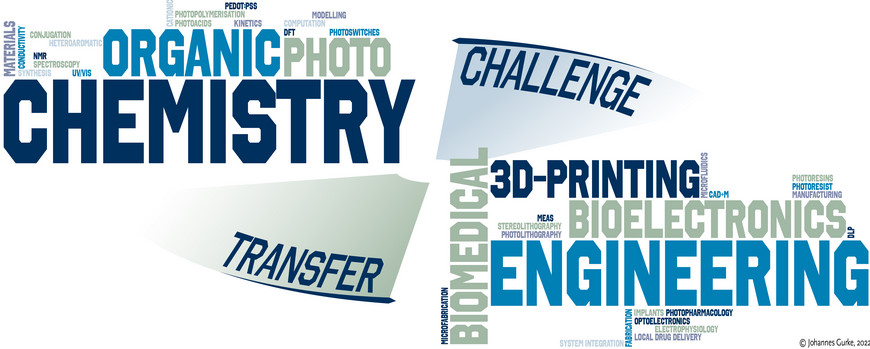Current Projects
Chemical Concepts to Enable Facile Additive Manufacturing of Advanced Device Architectures for Healthcare
The brain is an astonishing network of neurons rapidly processing its tasks. Understanding it is a fundamental endeavour and vital to help people with neurological disorders. Our brain is built in layers, a few hundred micrometers thick, and our interaction with it must pay tribute to this complexity in three dimensions. Yet, implants for recording neuronal signals, so-called microelectronic arrays, are limited by current fabrication methods. They are based on thin-film microfabrication, causing a laborious, inflexible production and a limited capability to achieve three-dimensional device architectures. Although modern 3D printing already allows the computer-aided design and manufacturing of most complex and even customised structures, it is not fully used for the described purpose. Hence, the project aims to overcome a fundamental constraint, namely the processing of conductive, polymeric materials with the most precise additive manufacturing technique, stereolithography. A new chemical concept will be developed to prepare conductive polymers with light and translate them to a highly electrically conductive yet biocompatible and flexible photoresin for state-of-the-art stereolithography setups. Building on those achievements, a novel photoinitiator system will allow the spatial differentiation between conductive and insulating material properties, using single resin stocks.
Intracranial Multimodal Probes for Acute, in vivo Photopharmacological Inhibition of Seizure-like Event
Interfacing with the human brain is a critical challenge for a deep understanding of neuronal processes and is the key for medicinal progress in treatment of neurological diseases, like epilepsy. An imbalance between excitatory and inhibitory signals has been discussed as a reason for epileptic seizures. The incorporation of an intracortical injection of anticonvulsants, bypassing obstacles like the blood–brain barrier, and a close-by measurement of neuronal activity is a promising therapeutic strategy. The diffusion of the drug after its local delivery in the targeted brain area limits the temporal resolution of this approach. This circumstance is aggravated by the fact that the exact prediction of seizure’s occurrence and intensity is still out reached, even though precise, intracortical measurements of the brain activity are possible. This makes a high temporal control over the antiseizure drug concentration within the target area even more important. The use of light appears to be a potent way to accomplish such a control, due to its non-invasive, harmless nature and achievement of high spatial and temporal resolution. The concept of photopharmacology is based on the structural interconnection of pharmacologic active agents with molecular photoswitches. Extensive studies on photoswitchable excitatory as well as inhibitory neurotransmitters for use in the central nervous system have been conducted, using light to reversibly de-/activate the pharmacological effect of the drug. The momentum in the field of optogenetics led to a wide range of implantable optoelectronic probes for in vivo illumination of biologic tissue. The merging of those disciplines, namely: photopharmacology, intracortical injection and measurement as well as implantable optoelectronics, might overcome the problems of each individual approach and provide a powerful tool for antiseizure therapy. To achieve this, light emitting diodes will be integrated in an implant with a flexible, organic electrode and a microfluidic system, injecting a photoswitchable drug. A constant monitoring of the neural activity by the device will allow the prediction of the seizure’s likelihood in future. If the forecast indicates an increased likelihood of an epileptic event inactive drug will be injected, having no effect on the neural activity. In case of actual seizure, red light irradiation will occur on demand, suppressing active potential firing by inhibiting the signal transmission in the glutamatergic synapses. Depending on the measured intensity of the seizure, the pharmacologically active drug concentration within the tissue will be increased by red light or decreased by blue light illumination, respectively, affording precise control.The integration of all system components in an implant, in particular its design, microfabrication, characterization and optimization towards the application will be the main task of this project.

